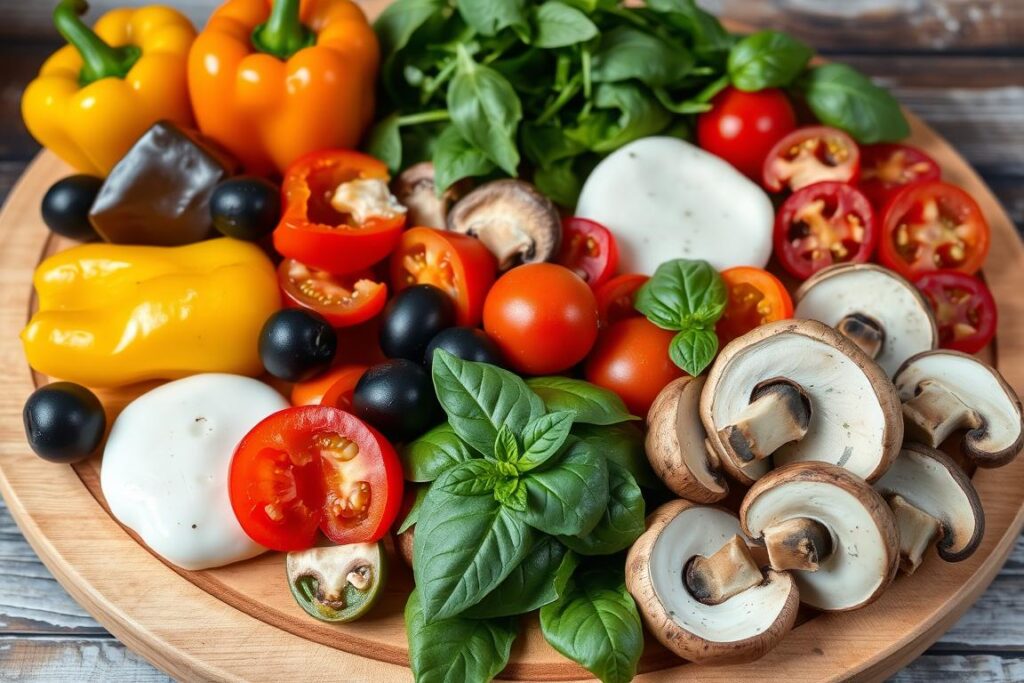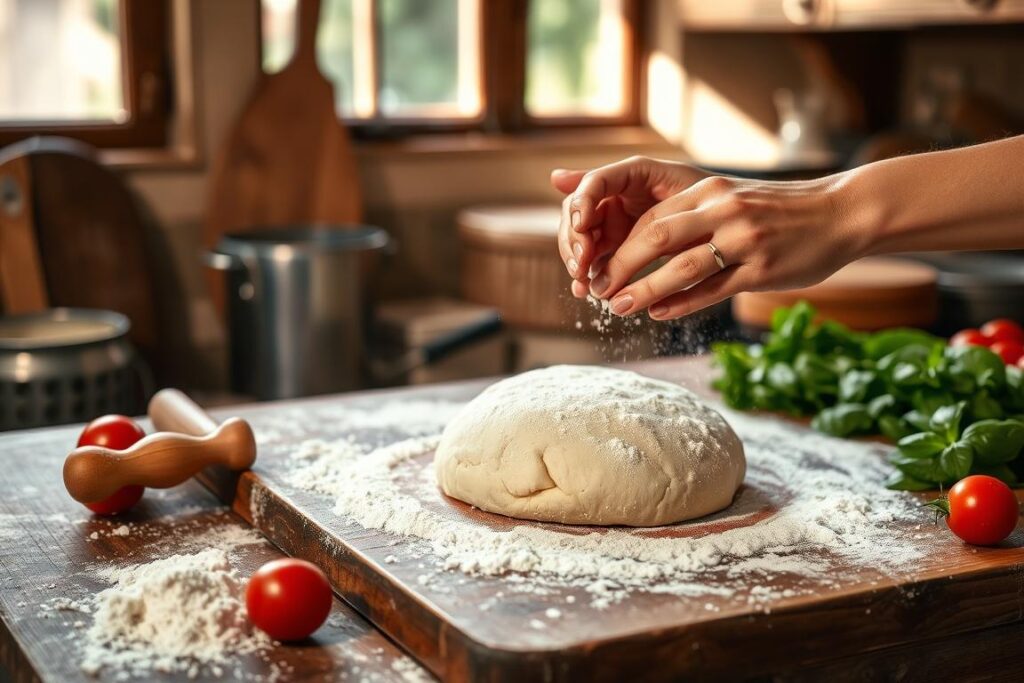Do you remember those cozy moments around the table? Laughter and a tasty smell filled the air. Pizza nights were always special, no matter the day. Making your own veggie pizza is more than just food; it’s a way to bring joy and warmth to your kitchen.
This easy veggie pizza recipe lets you choose every ingredient. You can make it just right for your family. With each bite, you’ll enjoy the flavors and feel proud of your healthy meal. Let’s explore how to make a delicious vegetable pizza that will make you and your loved ones happy.

Table of Contents
Introduction to Homemade Veggie Pizza
Making a homemade veggie pizza is a fun and rewarding experience. It lets you create your meal from scratch with fresh ingredients. You can customize it to match your taste, making it a delicious and easy vegetable pizza.
Choosing to make your own veggie pizza opens up a world of flavors. It’s a creative way to cook and a healthier choice than fast food. You’ll enjoy the satisfaction of making a meal that’s good for you.

This journey lets you try new textures and tastes. You can go for a classic Margherita or something more adventurous. The next parts will cover the benefits of cooking at home and the key ingredients for a great pizza.
Benefits of Making Veggie Pizza at Home
Making your own veggie pizza is great for your health. You get to pick fresh ingredients and make it just how you like it. This way, you can make a healthier pizza that fits your taste and diet.
Healthier Ingredients
At home, you can pick healthier ingredients for your pizza. Using whole-grain crusts or gluten-free options like broccoli crust makes it healthier. Broccoli is full of vitamin C and antioxidants, making it a great choice.
Homemade veggie pizza can be lower in calories. It’s a tasty way to eat well and show you care about your health.
Control Over Quality and Flavor
One big plus of making pizza at home is controlling the quality and flavor. You choose everything from fresh herbs to cheeses and toppings. This lets you create a meal that tastes great and is made with quality ingredients.
Ingredients like broccoli let you try out new flavors. You can mix and match to find the perfect taste for you.

Essential Ingredients for Your Veggie Pizza Recipe
Making the perfect easy vegetable pizza starts with picking the right ingredients. Knowing the best vegetarian pizza toppings and veggie pizza crust is key. This part will cover popular toppings and how to pick the right crust.
Vegetarian Pizza Toppings
Choosing the right toppings can turn a simple pizza into a flavorful masterpiece. Here are some great options:
- Chopped kale leaves: They add a nutritious crunch.
- Thinly sliced red and yellow bell peppers: These contribute sweetness and vibrant color.
- Red onion: Its slight pungency complements other toppings.
- Mushrooms: Known for their earthy flavor, they serve as a hearty option.
- Zucchini: Offers a subtle flavor and tender texture.
Using these ingredients makes your pizza colorful and nutritious. It’s both delicious and good for you.
Choosing the Right Veggie Pizza Crust
The crust is the base of a great veggie pizza. Here are some options to consider:
- Whole wheat crust: A healthier alternative packed with fiber.
- Broccoli crust: Gluten-free and rich in vitamins.
- Traditional thin crust: Perfect for those who prefer a crisper bite.
The right crust depends on what you like and your dietary needs. Broccoli crust is great for its health benefits and structure. Trying different crusts can make your homemade pizza even better.

How to Prepare the Perfect Pizza Dough
To make the perfect pizza dough, you need a few key ingredients. Start with 3 and 1/2 cups of unbleached all-purpose flour. Add one packet of yeast, a tablespoon of sugar, two tablespoons of olive oil, one teaspoon of salt, and about 1 and 1/3 cups of lukewarm water. You can also add cornmeal for extra texture.
First, mix yeast with lukewarm water and sugar. Let it foam for 5 to 10 minutes. Then, mix flour and salt in another bowl. Make a well in the center and add the yeast mixture and olive oil. Mix until a dough forms, then knead for 10 minutes until it’s smooth and elastic.
For better flavor, let the dough ferment overnight in the fridge. This slow process enhances taste and texture. If you’re short on time, let it rise for 90 minutes at room temperature until it doubles in size.
Once the dough is ready, divide it into portions. Each portion should weigh about 205 grams for a standard pizza. Roll it out to 0.5 cm thickness. Bake at 450°F (225°C) for 10 minutes for a crisp crust. With this dough, you’re set to make a delicious homemade veggie pizza.

Simple Steps for Making a Delicious Vegetable Pizza
Making a veggie pizza is easy and fun. Follow these steps to make a tasty pizza. Start by getting your ingredients ready. This makes cooking smooth and leads to a great meal.
Prepping Your Ingredients
First, wash your veggies well. Here’s a quick list to help you:
- 1 small head of broccoli (chopped into ½ cup)
- ⅓ cup halved cherry tomatoes
- Kernels from 1 ear of fresh corn
- ¼ cup coarsely chopped red onion
- ½ jalapeño pepper (thinly sliced)
- 4 oil-packed sun-dried tomatoes (diced)
Chop everything the same size for even cooking. This makes your pizza look good and taste great.
Assembling Your Pizza
Now, it’s time to put it all together! Roll out your dough to the right thickness. Place it on a baking sheet and start adding layers. Drizzle olive oil on the dough first.
Add your veggies evenly. For extra flavor, sprinkle some cheese on top. Cheddar cheese gives a sharper taste than mozzarella. Remember to preheat your oven to 475°F.
Bake for 15 minutes or until the crust is golden. Drizzle cashew cream on top for creaminess. These steps will help you make a delicious pizza to share.
Easy Veggie Pizza Recipe: Steps to Follow
Making a tasty vegetable pizza starts with a flavorful homemade pizza sauce. This sauce is the base of your easy veggie pizza recipe. It makes your dish taste better. After making the sauce, layer your toppings right. This way, every bite is full of great flavors.
Making the Pizza Sauce
Begin by picking good-quality canned or fresh tomatoes for your sauce. Here’s a simple way to do it:
- Crush or blend your tomatoes to get a smooth texture.
- Add minced garlic for a savory taste.
- Put in dried herbs like oregano, basil, and a pinch of red pepper flakes for a bit of heat.
- Season with salt and pepper to taste, and let it simmer for at least 15 minutes to deepen the flavors.
This homemade pizza sauce will be a great base for your delicious vegetable pizza. It will complement the fresh toppings you’ll add later.
Layering Your Toppings
Now that the sauce is ready, it’s time to layer your toppings. This step is key to the final taste and texture of your easy veggie pizza recipe. Here’s how to layer right:
- Spread an even layer of the homemade pizza sauce over your prepared pizza dough.
- Sprinkle a lot of mozzarella cheese, making sure it covers the whole surface for even melting.
- Add colorful vegetables like bell peppers, onions, mushrooms, and spinach, spreading them out for a balanced flavor.
- Top with more cheese and a sprinkle of Italian seasoning for extra flavor.
This layering method prevents sogginess and makes sure every slice of your delicious vegetable pizza is satisfying. Bake the pizza, following cooking tips for the best crust and toppings.
Cooking Tips for Ideal Veggie Pizza
Making the perfect veggie pizza is more than just great toppings and sauce. You also need to pay attention to oven temperature and timing. Follow these veggie pizza tips to get your pizza just right every time.
Oven Temperature and Timing
Preheat your oven to 450°F (232°C) for the best veggie pizza. This high heat helps make the crust crispy and cooks the toppings evenly. Bake your pizza for 15 to 20 minutes until it’s golden brown.
Let it cool for about 10 minutes before slicing. This prevents it from steaming and keeps it fresh.
Avoiding Floppy Pizza Crusts
Getting a non-floppy pizza crust can be tricky. Start by pre-baking your crust. Here’s how long to pre-bake based on crust thickness:
- Thin-crust: about 8 minutes
- Medium thickness: 10 to 12 minutes
- Thick-crust: 12 to 14 minutes
Too many toppings can make the crust soggy. Use just the right amount to keep your pizza healthy and easy to eat.
Popular Vegetarian Pizza Toppings You Can Try
Making a veggie pizza is a fun journey of discovery. There are so many vegetarian toppings to choose from. Each bite can be a burst of flavor. Fresh herbs and spices add a special touch to your pizza.
Trying new pizza combinations can make your dish unique. It will please many different tastes.
Fresh Herbs and Spices
Fresh herbs can make your pizza taste amazing. Try adding:
- Basil for a sweet, aromatic flavor
- Oregano, which complements the tanginess of tomato sauce
- Fresh parsley for a touch of freshness
Spices like black pepper and chili flakes are also great. They add depth and a bit of heat. These are key to a delicious flavor.
Exploring Unique Topping Combinations
Don’t be afraid to try new things. Think about unique pizza combinations like:
- Artichokes paired with sun-dried tomatoes
- Buffalo cauliflower for a spicy twist
- Grilled zucchini and eggplant for a Mediterranean vibe
These toppings can make your pizza unforgettable. The market for plant-based foods is growing. So, pick your favorite toppings and start making your own pizza!
Making Quick Veggie Pizza: Time-Saving Tips
Preparing a quick veggie pizza is perfect for busy weeknights. With a few smart tips, you can make a tasty pizza fast. This way, you can enjoy a meal with your family without spending hours in the kitchen.
Begin with pre-made pizza dough. It’s ready in just 10 minutes, making it easy to start adding toppings. This is a big help when you’re short on time. Use fresh, pre-chopped veggies to save even more time. Many stores have these ready, so you can get what you need quickly.
Ready-made sauces also speed up the process. They add flavor without the need to make your own. Just spread it on the dough, add your toppings, and bake.
For a quick veggie pizza night, prep ingredients ahead of time. Chopping veggies and storing them can save a lot of time. Use a high oven temperature, around 500°F, for a fast bake. By following these tips, you can make a delicious meal quickly. This leaves you more time to relax and enjoy the evening with your family.
Storing and Reheating Your Veggie Pizza
After making your veggie pizza, it’s important to store it right. Let it cool down completely to avoid a soggy crust. Wrap each slice in plastic wrap or foil to keep flavors in.
For fridge storage, use an airtight container for up to 3 days. Freezing is great for longer storage. Cool slices and freeze them in a bag or container for up to 2 months.
Reheating pizza is easy, but be careful with heat levels. Preheat your oven to 350°F. Place the pizza on a baking sheet and warm for 10 minutes. This method keeps the crust crispy and toppings tasty.
For a quicker option, try an air fryer at 400°F for 5-7 minutes. These tips help you enjoy your pizza for longer. Proper storage and reheating ensure your veggie pizza stays delicious.
Variations and Customizations for Your Veggie Pizza
Exploring veggie pizza variations opens a world of flavors tailored to specific dietary needs. Whether you are seeking nut-free pizza options or exploring gluten-free pizza crust alternatives, there are plenty of creative paths to take. You can enjoy a versatile dish that everyone can savor regardless of restrictions. Consider these suggestions to elevate your next homemade pizza experience.
Nut-Free Options
For individuals with nut allergies, crafting a delicious veggie pizza without nuts is straightforward. Focus on using:
- A variety of fresh vegetables like bell peppers, mushrooms, and spinach.
- Nut-free cheese alternatives, such as traditional mozzarella or other dairy options.
- Oils and dressings that do not contain any nut derivatives.
These nut-free pizza options ensure that the toppings burst with taste while catering to necessary health considerations.
Gluten-Free Crust Alternatives
If you serve a gluten-free audience, consider these delicious alternatives:
- Cauliflower crusts that provide a unique taste and texture.
- Chickpea flour-based dough, which offers a protein boost.
- Store-bought gluten-free pizza crusts that simplify preparation.
These gluten-free pizza crust choices do not sacrifice flavor and allow everyone to relish a savory slice. Get creative with toppings to complement these crusts and create a memorable dining experience.
Conclusion
Making a homemade vegetable pizza is more than cooking; it’s about feeding your family well. This simple veggie pizza recipe lets you try new flavors and please everyone at home. Using fresh ingredients like sautéed collard greens and pomegranate seeds makes your pizza healthier.
Plus, you can change up the toppings and crust to make it a hit with your family. Preparing ahead saves time, so you can bake it just before serving. With the right tips, like par-baking and using a mix of cheeses, every bite will be full of taste.
Your pizza can change with the seasons and special events, becoming a favorite dish. So, start making your own veggie pizza recipe. It’s a fun way to cook that your family will enjoy!
For more delicious recipes and cooking inspiration, check out Best Pizza Dough Recipe on our website!
FAQ
What makes homemade veggie pizza healthier than store-bought options?
Homemade veggie pizza lets you pick fresh, quality ingredients. You can choose whole-grain crusts, fresh veggies, and lower-fat cheese. This makes it healthier than many store-bought or delivery pizzas.
Can I customize my veggie pizza toppings?
Absolutely! Making homemade veggie pizza is fun because you can pick your favorite toppings. You can add bell peppers, mushrooms, spinach, or even artichokes or sun-dried tomatoes.
What type of crust is best for veggie pizza?
The best crust for veggie pizza is up to you. You can choose a thin crust, a hearty whole-wheat option, or gluten-free. This way, every slice is perfect for you.
How do I prevent my pizza crust from becoming soggy?
To keep your crust from getting soggy, pre-bake it for a few minutes before adding toppings. Also, don’t overload on moisture-rich toppings. Drain excess liquid from ingredients before layering.
What is the easiest way to make homemade pizza sauce?
Making homemade pizza sauce is easy. Just blend canned tomatoes with garlic, olive oil, fresh herbs, and seasonings. This quick method gives you a tasty sauce fast!
Can I make veggie pizza in advance?
Yes, you can prepare your veggie pizza ingredients and assemble it ahead of time. Store it in the fridge until you’re ready to bake. Or, freeze it for later, making meal prep a breeze!
What are some time-saving tips for busy weeknights when making veggie pizza?
For quick veggie pizza, use store-bought dough, pre-chopped veggies, and ready-made sauces. Meal prepping on weekends can also save time on busy evenings.
What is the best way to store leftover veggie pizza?
To keep leftover veggie pizza fresh, let it cool completely. Then, wrap slices tightly in plastic wrap or foil. Store them in an airtight container in the fridge.
Can I make a gluten-free veggie pizza?
Yes, you can! There are many gluten-free pizza crust options available. Or, you can make your own using almond flour or cauliflower for gluten-free diets.